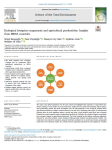Recepoglu M., Hayaloglu P., Cakir S.C., Artan S., Cakir M.A. (2025). Ecological footprint components and agricultural productivity: insights from MENA countries. Science of the Total Environment, 25/08/2025, vol. 992, p. 179852.
https://doi.org/10.1016/j.scitotenv.2025.179852
https://doi.org/10.1016/j.scitotenv.2025.179852
| Titre : | Ecological footprint components and agricultural productivity: insights from MENA countries (2025) |
| Auteurs : | M. Recepoglu ; P. Hayaloglu ; S.C. Cakir ; S. Artan ; M.A. Cakir |
| Type de document : | Article |
| Dans : | Science of the Total Environment (vol. 992, August 2025) |
| Article en page(s) : | p. 179852 |
| Langues : | Anglais |
| Langues du résumé : | Anglais |
| Catégories : |
Catégories principales 07 - ENVIRONNEMENT ; 7.5 - Dégradation : Impact, DésertificationThésaurus IAMM EMPREINTE ECOLOGIQUE ; AGRICULTURE ; DEGRADATION DE L'ENVIRONNEMENT ; PRODUCTIVITE ; RENDEMENT DES CULTURES ; MOYEN ORIENT ; AFRIQUE DU NORD |
| Résumé : | The surge in the global population over the past century has highlighted the importance of agricultural production, leading to many studies to boost productivity. Unlike previous studies that primarily explore agricultural productivity growth, this study investigates how the subcomponents of the ecological footprint affect agricultural productivity in MENA countries between 1992 and 2021, identifying which types of environmental pollution have the most significant impact. Driscoll and Kraay (1998) method results show that ecological footprint has a major negative impact on agricultural productivity. Similarly, all ecological footprint components have a negative impact on agricultural productivity. The forest footprint has the highest coefficient magnitude, followed by crop land footprint, carbon footprint, fishing grounds footprint and grazing land footprint. The results have been tested for robustness using the Half-Panel Jackknife test to avoid biased results, and parallel results have been obtained. Finally, the causality between agricultural productivity and explanatory variables has been tested using Dumitrescu and Hurlin (2012) panel causality test. The findings suggest that policymakers may find it more effective to eliminate pollution rather than using additional resources to increase agricultural productivity. This approach allows for the reallocation of resources used in agricultural production to other areas. |
| Cote : | Réservé lecteur CIHEAM |
| URL / DOI : | https://doi.org/10.1016/j.scitotenv.2025.179852 |







